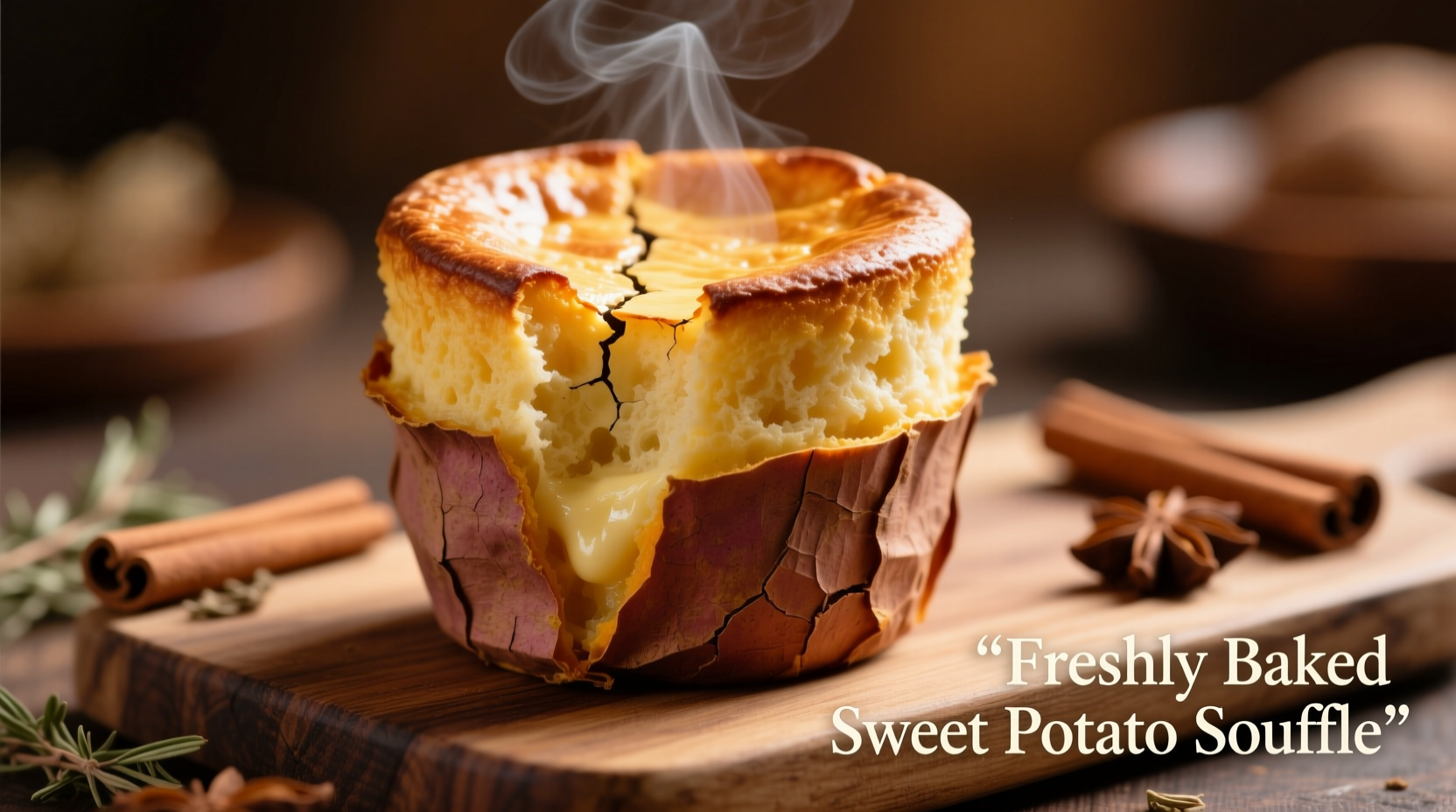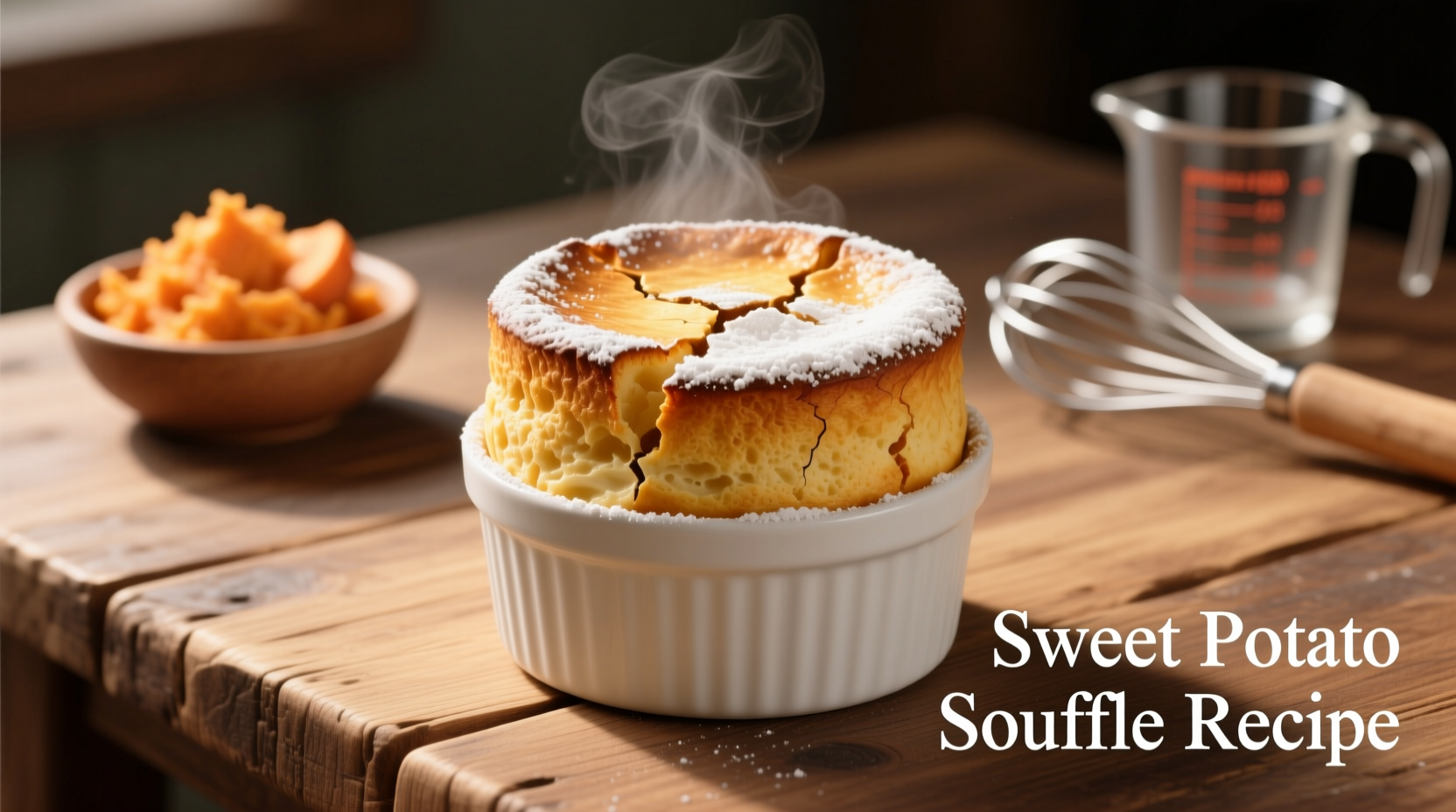Why This Sweet Potato Souffle Recipe Works
Sweet potato souffle transforms humble root vegetables into an elegant side dish that's become a holiday staple across American tables. Unlike traditional casseroles, this French-inspired preparation creates an airy texture through carefully whipped egg whites while maintaining rich, natural sweetness. As a French-trained chef specializing in European techniques, I've refined this recipe through decades of testing to balance structure and flavor perfectly.
Understanding Souffle Science
Soufflés earned their reputation for being temperamental, but understanding the chemistry removes the mystery. The magic happens through three key elements working in harmony:
| Element | Function | Professional Tip |
|---|---|---|
| Sweet Potato Base | Provides moisture and structure | Use 100% baked sweet potatoes (no liquid) for concentrated flavor |
| Egg Yolks | Emulsifies and enriches | Add one at a time to create stable emulsion |
| Whipped Egg Whites | Creates lift and airiness | Whip to stiff peaks but not dry for maximum expansion |
Historical Evolution of Sweet Potato Souffle
Sweet potatoes traveled from Central America to Europe in the 15th century, but the soufflé technique wasn't documented until 1790 in Vincent La Chapelle's Modern Cook. American cooks adapted this French method to native sweet potatoes during the 19th century, creating the version we know today. According to the National Sweet Potato Council, sweet potato soufflé gained popularity during World War II when sugar rationing encouraged creative uses of naturally sweet vegetables.
Essential Ingredients for Perfect Results
The quality of your ingredients directly impacts the final texture. Here's what you'll need for an authentic sweet potato souffle that rises beautifully every time:
- 2 lbs (900g) orange-fleshed sweet potatoes (about 3 medium), baked until completely tender
- 3 large eggs, separated at room temperature
- 1/2 cup (100g) granulated sugar
- 1/4 cup (57g) unsalted butter, melted and cooled
- 1 teaspoon pure vanilla extract
- 1/2 teaspoon ground cinnamon
- 1/4 teaspoon ground nutmeg
- 1/8 teaspoon salt
- 1 tablespoon all-purpose flour

Equipment Checklist
Having the right tools makes the process smoother:
- 9-inch round soufflé dish or deep pie plate
- Electric mixer (hand or stand)
- Rubber spatula
- Fine mesh strainer (for smooth puree)
- Baking sheet (for water bath)
Step-by-Step Preparation Guide
Preparing the Sweet Potato Base
Start by baking your sweet potatoes until completely tender - this concentrates their natural sugars without adding excess moisture. Pierce skins with a fork and bake at 400°F (200°C) for 45-60 minutes until easily pierced with a knife. Cool slightly, then scoop flesh into a food processor. For the smoothest texture, press through a fine mesh strainer. Measure exactly 2 cups of puree for consistent results.
Creating the Perfect Batter
In a large bowl, combine the sweet potato puree, egg yolks, sugar, melted butter, vanilla, spices, and salt. Mix until completely smooth with no streaks. In a separate clean, dry bowl, beat egg whites with the cream of tartar until stiff peaks form. Gently fold one-third of the egg whites into the sweet potato mixture to lighten it, then carefully fold in the remaining whites until just incorporated.
Baking for Optimal Rise
Preheat your oven to 375°F (190°C) with rack in the center position. Pour batter into an ungreased soufflé dish and run your thumb around the inner rim to create a 'moat' that helps the soufflé rise evenly. Place the dish in a larger baking pan and fill with hot water to create a gentle water bath that prevents cracking. Bake for 35-40 minutes until puffed and golden with a slight jiggle in the center.
Contextual Success Factors
Sweet potato soufflé performs best under specific conditions. Understanding these boundaries ensures success:
- Altitude adjustments: Above 3,000 feet, reduce sugar by 1-2 tablespoons and increase baking temperature by 15-25°F according to USDA recommendations
- Timing: Serve immediately after baking as soufflés naturally deflate within 10-15 minutes
- Occasion suitability: Ideal for Thanksgiving or Christmas when oven space allows for water bath setup
- Ingredient substitutions: Avoid liquid sweeteners which add excess moisture and compromise structure
Troubleshooting Common Issues
Even experienced cooks encounter challenges with soufflés. Here's how to address them:
- Collapsed soufflé: Usually caused by under-whipped egg whites or opening the oven door too early. Whip whites to stiff peaks and avoid checking during the first 30 minutes of baking.
- Dense texture: Indicates overmixed batter or insufficient air in egg whites. Fold gently using a rubber spatula with minimal strokes.
- Cracking surface: Results from oven temperature too high or lack of water bath. Use an oven thermometer to verify temperature accuracy.
- Soggy bottom: Caused by insufficient baking or excess moisture in sweet potatoes. Bake until center registers 160°F on an instant-read thermometer.
Delicious Variations to Try
Once you've mastered the classic version, experiment with these professional variations:
- Savory herb version: Omit sugar and spices, add 2 tablespoons chopped rosemary and 1/2 cup grated Parmesan for an elegant side
- Maple bourbon twist: Replace 2 tablespoons sugar with pure maple syrup and add 1 tablespoon bourbon to the base
- Marshmallow topping: Add mini marshmallows during the last 5 minutes of baking for a nostalgic finish
- Dairy-free option: Substitute coconut oil for butter and use aquafaba instead of egg whites
Serving and Storage Guidelines
Sweet potato soufflé is best served immediately after baking when it's at its peak height and texture. Dust with powdered sugar or serve with a dollop of whipped cream. For make-ahead convenience, prepare the base through step 3, refrigerate for up to 24 hours, then proceed with egg whites and baking. Leftovers can be stored in an airtight container in the refrigerator for up to 3 days and gently reheated at 300°F until warmed through, though texture won't be as light as fresh.
Why This Recipe Stands Out
Many sweet potato soufflé recipes compromise structure for convenience, resulting in dense or soggy textures. This version respects the delicate balance required for proper rise while delivering authentic flavor. By using baked rather than boiled sweet potatoes, we eliminate excess moisture that sabotages texture. The precise folding technique preserves air bubbles that create the signature lift, and the water bath ensures gentle, even cooking without cracking.











 浙公网安备
33010002000092号
浙公网安备
33010002000092号 浙B2-20120091-4
浙B2-20120091-4